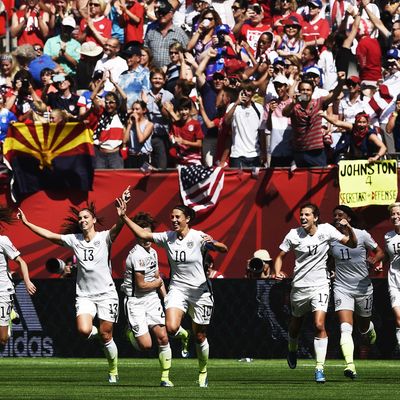
Here’s a trivia question for you: What’s the last sports team to receive a ticker-tape parade through the Canyon of Heroes in New York City? The only team in the last seven years, I might add.
The answer is the 2015 United States Women’s National Soccer Team, which won the World Cup four years ago. They were the first Americans that weren’t part of a New York sports team to ride through the Canyon of Heroes since John Glenn and the astronauts of Space Shuttle Discovery mission STS-95 did back in 1998, and they were the first national sports team to receive the honor since the 1984 U.S. Olympic team. (They were also the first women’s sports team to ever make the parade, though, perhaps inevitably, Bill de Blasio got himself a spot on the float regardless.) The Dream Team didn’t get that honor. The Miracle on Ice didn’t get that honor. No pope has gotten that honor in 40 years. But the 2015 Women’s World Cup winners did.
We can argue the merits of their inclusion, historically speaking — I think they deserved one, but, you know, Muhammad Ali and Michael Jordan probably did at some point too — but it sure made sense at the time. The USWNT, a team oozing with charisma and star power, from young stars like Carli Lloyd to beloved veterans like Megan Rapinoe to “controversial” goalkeeper Hope Solo, won the U.S.’s first World Cup since the famous 1999 team and Brandi Chastain’s penalty-kick winner. They were also the biggest American women’s sports phenomenon since that 1999 team, with a massive national ad campaign behind them, sold out crowds following them around their games in Canada, and the righteous indignation of shoving their (and their tournament’s) success in the face of recently ousted FIFA head Sepp Blatter, who had suggested that, in order to boost their sport’s popularity, players should wear “tighter shorts.” (Solo would later accuse Blatter of sexual assault. ) The 2015 USWNT not only ended up a bigger deal than the 1999 team, they outpaced nearly every other team and sport in the country. Their World Cup victory in Japan ended up garnering the highest television ratings of any U.S. soccer match ever, and more people watched it that year than the World Series or the NBA Finals. It was a big freaking deal. It felt like the prelude to a new chapter in American women’s sports. Movements have been launched with less.
This Friday, the next Women’s World Cup, held in France this time, kicks off, and it is worth asking: How many of the lofty hopes inspired by the 2015 USWNT have been fulfilled in the last four years? When the USWNT set all those television ratings records and made everyone feel so great, many thought it would be a breakthrough for women’s sports in the United States. But has it been?
The audiences seem to have shown up. If you’re going by television ratings — a rough measure, to be sure, but at least a noisy indicator of national interest — signs are good. WNBA ratings have gone up steadily in the last four years and are so far this year at a six-year high, and the Women’s College World Series was unquestionably a hit for ESPN this year. (Softball, revenue-wise, is now the fourth-biggest collegiate sport.) Serena Williams is by far the most popular tennis player in the world. There have even been improvements media-wise: This year’s Women’s World Cup is going to be blanketing your Fox television screens for the next month, and last month the Athletic announced that it would have dedicated beat reporters for each WNBA team, the first media organization to even come close to doing so. Women’s sports are a larger part of the sports landscape than they have ever been, and they’re growing.
The industry that surrounds them, however, and in particular the economy around them, continues to lag considerably. WNBA players are famously underpaid, and not just relative to NBA players; they receive only 25 percent of WNBA revenue, which is half of the 50 percent NBA players receive. Seattle Storm star Breanna Stewart, the reigning WNBA MVP, will miss this entire season because of an injury she suffered playing in Europe in the off season, where she was playing because her WNBA salary was only $64,538, requiring her to supplement her income when the WNBA isn’t in season. (It should come as no surprise that this inspired the Federalist to claim that WNBA players were in fact overpaid.) Despite women’s tennis being as popular (perhaps even more so) as men’s tennis, the pay gap among professional players is almost precisely the pay gap in American society, with women making 80 cents on the men’s dollar.
But if you’re really looking for how little progress has been made since the 2015 USWNT victory, look no further than … the USWNT. In March, on International Women’s Day and timed to build up to this very tournament, the women’s national team players filed a gender discrimination lawsuit against U.S. Soccer, claiming dramatic disparities between women’s bonuses and the bonuses paid to the far-less-successful men’s team (which didn’t even qualify for last year’s World Cup). (They had previously alleged wage discrimination with the Equal Employment Opportunity Commission back in 2016.) The women’s team has expressed frustration about having to play on artificial turf more often, and pointed out that the maximum salary for a women’s player, playing 20 exhibitions a year, was nearly a third of what it was for a men’s player doing the same. This was especially evident, says the lawsuit, in the year after the World Cup victory, in which U.S. Soccer brought in “$17 million in unexpected profit,” a large percentage of which came from that women’s team’s success. (2017 was the year the men’s team blew their World Cup chances by losing to Trinidad and Tobago on the last day of qualifying.)
This isn’t just a small segment of disgruntled players either. The whole team, along with several former players, has signed on, including stars Rapinoe, Lloyd, and Alex Morgan. (Rapinoe is in fact staging a “silent protest” throughout the World Cup, also in defiance of U.S. Soccer.) These are the biggest stars, given the biggest platform they’ve had since they created their own four years ago, screaming to be heard about injustice. It goes beyond U.S. Soccer too. The highly regarded French women’s team recently had to give up their practice facilities so the men’s team could practice for an exhibition, and FIFA, absurdly, has scheduled championships for two men’s tournaments (the Copa America and the Gold Cup) on the same day as the Women’s World Cup final. It seems, somehow, to be getting worse.
When the USWNT won the World Cup in 2015, it seemed like a new day dawning for women’s sports in this country, and even around the world. And now here are all those heroes, returning to the world stage, and their message is one of unity and defiance. Last time their win was a feel-good story. This time, a win could be mean something much more.
Will Leitch’s Games column runs weekly. Email him at will.leitch@nymag.com.






























